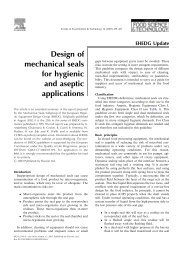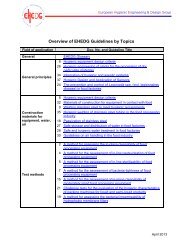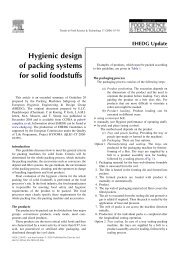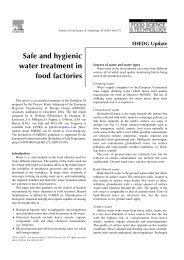Yearbook 2013/2014 - ehedg
Yearbook 2013/2014 - ehedg
Yearbook 2013/2014 - ehedg
You also want an ePaper? Increase the reach of your titles
YUMPU automatically turns print PDFs into web optimized ePapers that Google loves.
68 Flow behaviour of liquid jets impinging on vertical walls<br />
Application to cleaning<br />
Since R, and hence W, can now be estimated from Equation<br />
(1), we can obtain a reasonable estimate of the wall area<br />
contacted by the liquid in the jet and the stability of the falling<br />
film generated. The influence of surfactants or the effect of<br />
cleaning the surface, which will change the contact angle,<br />
can also be assessed. Ongoing work in our group includes<br />
investigations of inclined jets and non-vertical surfaces,<br />
detailed analysis of the shape of the falling films, and<br />
cleaning.<br />
Acknowledgment<br />
This work is not funded by a company or research council.<br />
A PhD scholarship for Tao Wang and input from project<br />
students is gratefully acknowledged.<br />
References<br />
Figure 4. Plot indicating stability of falling films generated by<br />
horizontal jets impinging on a vertical glass wall. The lines show the<br />
Hartley and Murgatroyd criterion, Equation (2), for water (in blue)<br />
and an aqueous 0.1 mM Tween 20 solution (in red). Data points:<br />
open symbols indicate that rivulet flow was observed, solid symbols<br />
indicate gravity flow. Rivulet flow is expected for points lying on or<br />
above the line. Test conditions: 1 mm nozzle, 20ºC.<br />
The two lines on Figure 4 show the conditions under which<br />
Equation (2) predicts a change in flow behaviour for water<br />
and for a surfactant solution. The theory says that points lying<br />
on or above the line should exhibit rivulet flow behaviour. For<br />
the flow rates tested here, water exhibits rivulet flow, which<br />
is consistent with Equation (2).<br />
1. Morison, K.R., and R.J. Thorpe. (2002). Liquid distribution from<br />
cleaning-in-place sprayballs. Food Bioproducts Proc., 80, 270-275.<br />
2. Wilson, D.I., B.L. Le, H.D.A. Dao, K.Y. Lai, K.R. Morison, and<br />
J.F. Davidson. (2011). Surface flow and drainage films created by<br />
horizontal impinging liquid jets. Chem. Eng. Sci., 68, 449–460.<br />
3. Wang, T., Davidson, J.F. and Wilson, D.I. (<strong>2013</strong>) 'Effect of<br />
surfactant on flow patterns and draining films created by a horizontal<br />
liquid jet impinging on a vertical surface', Chem. Eng. Sci., 88, 79-94.<br />
4. Hartley, D.E. and W. Murgatroyd. (1964). Criteria for the breakup<br />
of thin liquid layers flowing isothermally over solid surfaces. Intl<br />
J. Heat Mass Transfer, 7, 1003-1015.<br />
The presence of surfactant reduces the surface tension and<br />
gives a smaller contact angle, which causes the transition<br />
locus to move to larger Eötvös numbers. For similar flow<br />
rates to the water tests, the surfactant solutions give wide<br />
falling films, which is again consistent with Equation (2).
















